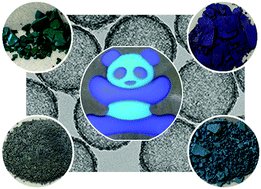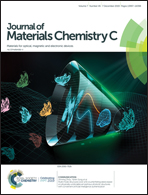Multi-colored hollow carbon-containing titania nanoshells for anti-counterfeiting applications†
Abstract
While titania and carbon are conventionally perceived as white and black materials, here we show that their combination in the form of composite hollow nanoshells can display striking colors with considerably high contrast through resonant Mie scattering. Our unique design utilizes hollow nanostructures to produce the color by minimizing random multiple scattering and the incorporated carbon species to act as an internal black background to suppress multiple scattering and enhance the color contrast. Synthesized through a simple sol–gel process followed by high-temperature carbonization, these hollow carbon-containing titania (C-TiO2) nanoshells can exhibit variable bright colors from purple to blue and green by controlling their diameter. They can be conveniently used as alternative pigments in many color-related applications, with the advantages of high chemical and optical stability and low toxicity that are associated with titania and carbon materials and the structural coloration mechanism. In addition, as the visible Mie scattering responds rapidly and reversibly to changes in the surrounding medium, these nanoshells may also serve as active color components for many applications that require dynamic color switching, such as signage and displays, colorimetric sensors and detectors, and anti-counterfeiting devices.

- This article is part of the themed collection: 2019 Journal of Materials Chemistry C HOT Papers


 Please wait while we load your content...
Please wait while we load your content...
